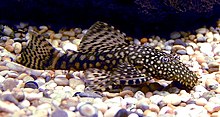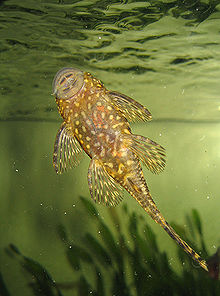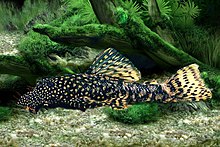Antennae armor catfish
| Antennae armor catfish | ||||||||||||
|---|---|---|---|---|---|---|---|---|---|---|---|---|
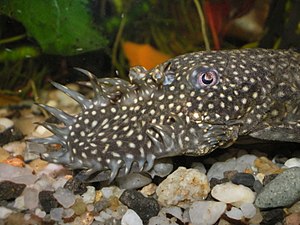
Head of a male catfish |
||||||||||||
| Systematics | ||||||||||||
|
||||||||||||
| Scientific name | ||||||||||||
| Ancistrus | ||||||||||||
| Kner , 1854 |
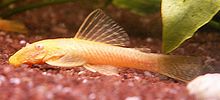
The antenna catfish ( Ancistrus , Syn .: Xenocara ), also called antenna catfish , are a genus of the armor catfish and the largest group within the subfamily Ancistrinae . New species are often described, about 75 species are currently known. Type species is Ancistrus cirrhosus (originally Hypostomus cirrhosus ).
Because of their conspicuous appearance, the uncomplicated keeping of many species and their reproduction in captivity, aerial armor catfish are often kept in the aquarium hobby.
distribution and habitat
Antenna armored catfish live in northern and central South America , their habitat extends to the Río de la Plata in the south and to Suriname in the north . Most species live in rivers. Overall, however, the populated habitats are diverse. They range from fast-flowing rivers to stagnant bodies of water in floodplains and swamps.
features
Typical is a more or less dorsoventrally flattened body structure and a suction mouth with numerous fine teeth. The interoperculare (a bone of the gill cover ) is covered with spiky skin teeth, the odontodes , and can almost always be turned out. The operculare (another bone of the gill cover) is usually also freely movable. The sides of the body are armored with bone plates, which in many cases also have skin teeth. The abdomen and the first quarter of the head are bare. The most obvious feature are tentacle-like attachments on the front part of the head. In the males of some species these can also branch, in females they are less pronounced or absent entirely.
Way of life
Ancistrus eat like all loricariids mainly on algae and periphyton , but are not pure vegetarians. They live strongly on the ground and only swim short distances freely. Antenna armored catfish are very peaceful towards non-species fish. Internally, the territorial males can become very aggressive towards each other, especially during spawning time. For reproduction, caves are preferred, on the walls of which the female attaches up to 200 orange-colored eggs about three millimeters in size in a cluster. The clutch is guarded by the male. The larvae hatch after about five days. They then feed on their yolk sac for about five more days. Then they leave the shelter and look for food independently.
Systematics
- Genus Antennen-Armischwelse ( Ancistrus ) Kner, 1854
- Ancistrus aguaboensis Fisch-Muller, Mazzoni & Weber, 2001
- Ancistrus amaris Souza et al., 2019
- Ancistrus bodenhameri Schultz, 1944
- Ancistrus bolivianus (Steindachner, 1915)
- Ancistrus brevifilis Eigenmann, 1920
- Ancistrus brevipinnis (Regan, 1904)
- Ancistrus bufonius (Valenciennes, 1840)
- Ancistrus caucanus Fowler, 1943
- Ancistrus centrolepis Regan, 1913
- Ancistrus chagresi Eigenmann & Eigenmann, 1889
- Ancistrus cirrhosus (Valenciennes, 1836)
- Ancistrus claro Knaack, 1999
- Ancistrus clementinae Rendahl , 1937
- Ancistrus cryptophthalmus rice, 1987
- Ancistrus cuiabae Knaack, 1999
- Ancistrus damasceni (Steindachner, 1907)
- Blue catfish ( Ancistrus dolichopterus ) Kner, 1854
- Ancistrus dubius Eigenmann & Eigenmann, 1889
- Ancistrus erinaceus (Valenciennes, 1840)
- Ancistrus eustictus (Fowler, 1945)
- Ancistrus formoso Sabino & Trajano, 1997
- Ancistrus fulvus (Holly, 1929)
- Ancistrus galani Perez & Viloria, 1994
- Ancistrus gymnorhynchus Kner, 1854
- Ancistrus heterorhynchus (Regan, 1912)
- Ancistrus hoplogenys (Günther, 1864)
- Ancistrus jataiensis Fisch-Muller, Cardoso, da Silva & Bertaco, 2005
- Ancistrus jelskii (Steindachner, 1877)
- Ancistrus karajas Oliveira et al., 2016
- Ancistrus kellerae Souza et al., 2019
- Ancistrus krenakarore Oliveira et al., 2016
- Ancistrus latifrons (Günther, 1869)
- Ancistrus leoni Souza et al., 2019
- Ancistrus leucostictus (Günther, 1864)
- Ancistrus lineolatus Fowler, 1943
- Ancistrus lithurgicus Eigenmann, 1912
- Ancistrus macrophthalmus (Pellegrin, 1912)
- Ancistrus maculatus (Steindachner, 1881)
- Ancistrus malacops (Cope, 1872)
- Ancistrus maracasae Fowler, 1946
- Ancistrus martini Schultz, 1944
- Ancistrus mattogrossensis Miranda Ribeiro, 1912
- Ancistrus maximus de Oliveira et al., 2015
- Ancistrus megalostomus Pearson, 1924
- Ancistrus minutus Fisch-Muller, Mazzoni & Weber, 2001
- Ancistrus montanus (Regan, 1904)
- Ancistrus multispinis (Regan, 1912)
- Ancistrus nudiceps (Müller & Troschel, 1849)
- Ancistrus occidentalis (Regan, 1904)
- Ancistrus occloi Eigenmann, 1928
- Ancistrus parecis Fisch-Muller, Cardoso, da Silva & Bertaco, 2005
- Ancistrus patronus Souza et al., 2019
- Ancistrus pirareta Muller, 1989
- Ancistrus piriformis Muller, 1989
- Ancistrus ranunculus Muller, Rapp Py-Daniel & Zuanon, 1994
- Ancistrus reisi Fisch-Muller, Cardoso, da Silva & Bertaco, 2005
- Ancistrus sadades Souza et al., 2019
- Ancistrus salgadae Fowler, 1941
- Ancistrus spinosus Meek & Hildebrand, 1916
- Ancistrus stigmaticus Eigenmann & Eigenmann, 1889
- Ancistrus tamboensis Fowler, 1945
- Ancistrus taunayi Miranda Ribeiro, 1918
- Yellow-brown catfish ( Ancistrus temminckii ) (Valenciennes, 1840)
- Ancistrus tolima Taphorn et al., 2013
- Ancistrus tombador Fisch-Muller, Cardoso, da Silva & Bertaco, 2005
- Ancistrus trinitatis (Günther, 1864)
- Ancistrus triradiatus Eigenmann, 1918
- Ancistrus variolus (Cope, 1872)
- Ancistrus verecundus Fisch-Muller, Cardoso, da Silva & Bertaco, 2005
- Ancistrus vericaucanus Taphorn et al., 2013
- Ancistrus yutajae Souza et al., 2019
Code system in aquaristics
A code system was introduced for aquarists in 1988, the so-called L numbers . The reason for this was the import of highly diverse, as yet undescribed armored catfish. The "L" comes from their family name Loricariidae , the number refers to the order of publication in DATZ .
See also
Web links
- Antennen-Armischwelse on Fishbase.org (English)
- Ancistrus (English)
literature
- Axel Zarske: Ancistrus Kner, 1854. Antennenwelse. In: Claus Schaefer, Torsten Schröer (Hrsg.): The large lexicon of aquaristics. Eugen Ulmer, Stuttgart 2004, ISBN 3-8001-7497-9 , p. 52 f.
- Günther Sterba : Freshwater fish in the world. Weltbild Verlag, Augsburg 1998, ISBN 3-89350-991-7 .
